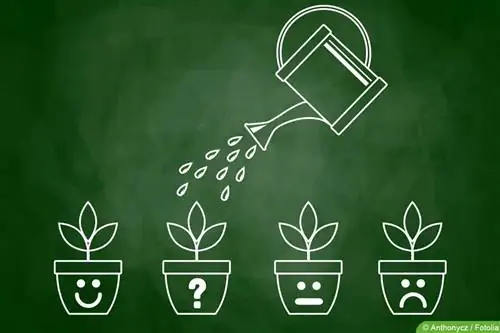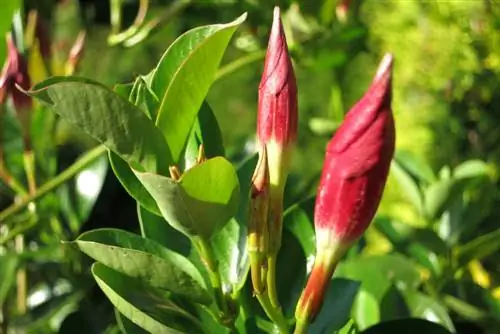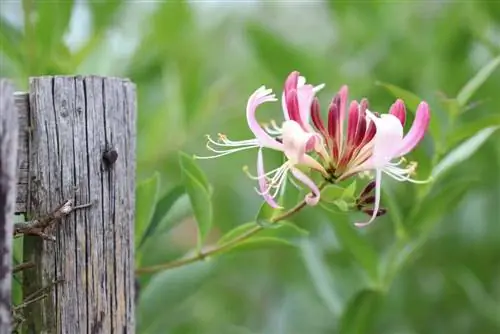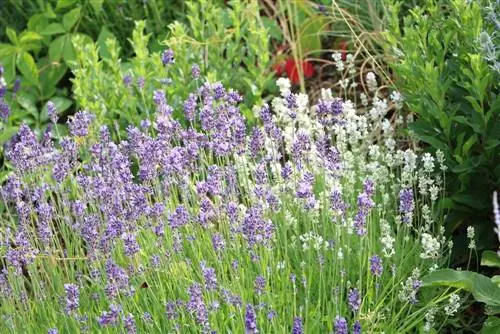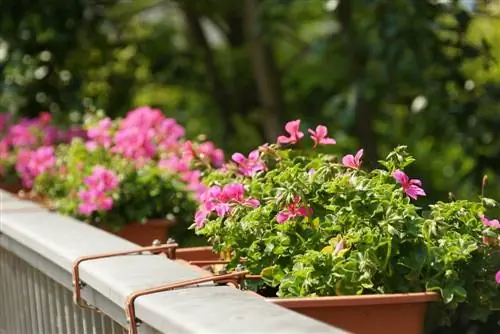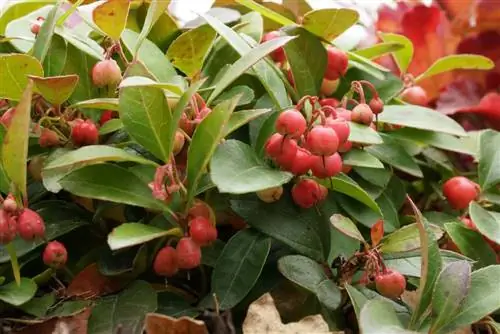- Author admin [email protected].
- Public 2023-12-17 03:39.
- Last modified 2025-01-24 12:45.
For indoor potted plants, the correct water supply depends on various factors that can be overwhelming, especially for beginners. 15 tips to help you water your houseplants as effectively as possible.
5 potted plant watering types presented
An often overlooked point when watering houseplants is the type of watering. This refers to the watering process, which is influenced by the type of plant and the planter. The most well-known methods are watering the substrate from above or using a saucer that is filled with water. There are other types of watering, but which one is right for your potted plants? The following tips are here to help you:
From above
One of the most common ways to water houseplants is from above. This means that the substrate surface is wetted with the water, which then seeps into the soil and supplies the roots with moisture. It is a straightforward method that is suitable for the majority of indoor potted plant species available. However, you should make sure that you do not water the plant itself, but only the substrate. You should also always empty out any water that has accumulated in the saucer after some time. This will prevent waterlogging.
Note:
Use your hand as a shield to reduce water splashes when pouring onto the substrate. This way, less moisture reaches the plant directly.
From below
In addition to the variant from above, some plants like to be watered from below over the saucer or a planter. You simply pour the water into the planter and the substrate absorbs the moisture. The biggest advantage of this method: theoretically, you cannot add too much water if you empty the saucer after watering. The following plants are well suited for this watering method:
- Species with sensitive leaves such as mimosa (Mimosa pudica)
- Bubikopf (Soleirolia soleirolii)
- tuber plants
- African Violet (Saintpaulia Ionantha)
- Room cyclamen (Cyclamen persicum)
Spraying instead of pouring
Certain plants prefer to be sprayed rather than watered unless this option is used to improve humidity. In this case, use a spray bottle filled with water to regularly spray either the entire plant or just the roots. Epiphytes in particular rely on this method because they either do not sit in a traditional substrate or absorb a lot of moisture through their leaves:
- Bromeliads (Bromeliaceae)
- Ferns like the nest fern (Asplenium nidus)
- Tillandsia (Tillandsia)
- Vanda Orchids (Vanda)
Diving potted plants
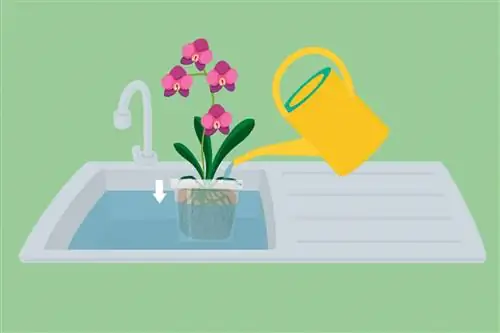
Potted plants can also be dipped to completely moisten the roots and substrate in one go and then allow them to drain. To do this, the plant and the bucket are placed in a water bath until no more air bubbles rise from the substrate. The remaining water should then be able to drain away. This method is also used for epiphytes, whose roots are dipped into water for a few minutes. This method is also suitable for the following plants and substrates:
- highly humus substrates
- substrates rich in peat
- Coniferous earth
- moisture-loving plants such as arum (Arum) or window leaves (Monstera)
Pouring systems
An exception to the previous types is the use of casting systems. Watering or watering systems automatically supply your potted plants with water over a certain period of time. They are designed so that the bucket is equipped with a water reservoir. Depending on the moisture level of the substrate, only water is fed via a connection from the reservoir into the inside of the pot when it needs to be watered. For this reason, the systems are ideal for potted plants when you go on vacation. When choosing a system, consider water needs. Two types are mainly offered:
- Systems for thirsty plants
- Systems for plants with low water requirements
Note:
If you have planters in hard-to-reach places, irrigation systems are also helpful. This means you only have to refill the reservoir at regular intervals, which significantly reduces the amount of work and time required.
Avoid casting errors: 5 tips
It's not just the different types of watering that need to be taken into account in the daily care of houseplants. Watering errors that cause indoor plants to evaporate, drown or rot can often lead to problems. To prevent your potted plants from dying due to watering, you should take a look at the following 5 tips:
Water as needed
With a few exceptions such as the moisture-loving flamingo flower (anthurium) or numerous ferns, most potted plants should only be watered as needed. This means that you only water when the top layer of soil in the substrate has dried out. This will ensure that there is no excess water. You check the moisture using the finger test in the following way:
- Select location in the substrate
- Put your finger in the ground
- Depth: about 2 cm
- Check the soil layer for moisture
- water when dry
Note water hardness
Houseplants represent an extensive selection of plants, all of which have different requirements for irrigation water. Incorrect water hardness has a negative effect on the vitality of the plant, as many houseplants, for example, cannot tolerate lime. Therefore, check in advance whether the potted plants are sensitive to limescale. If so, you should avoid calcareous (hard) tap water and use the following:
- Filter water
- boiled and cooled water
- stale water
Right time of day
It's not just the frequency and type that are important when watering your houseplants. Potted plants should never be watered during midday when it is sunny. The midday sun causes the irrigation water to evaporate more quickly, which means the plants dry out more quickly. At the same time, the leaves can burn if droplets of water land on them during watering. The water acts like a magnifying glass, causing damage. Water your houseplants preferably at the following times of day:
- morning
- afternoon
Forgotten drainage
If you have the feeling that the water in the bucket is not draining properly, a lack of drainage may be the reason. Depending on the drainage material, a different effect is achieved. If you mix sand into the substrate, it will be loosened up. This makes it much easier for water to reach the ground through the earth. This method is particularly suitable for heavy substrates such as soil with a high clay content that are only slightly permeable. The other method involves laying drainage material at the bottom to protect the drainage holes from substrate clogging. This allows the water to drain unhindered after watering. The following materials are suitable for this:
- gravel
- pottery shards
- Perlite
- lava granules
- expanded clay
Water temperature

Pay attention to the water temperature when watering your potted plants. Water that is too cold or warm can damage the roots, which in the long term has a negative impact on the vitality of the plant. Water at a temperature similar to room temperature is ideal for watering since you are cultivating indoor plants. You should never water houseplants as follows:
- with ice cold water
- with boiling water
5 more watering tips
In addition to the points already mentioned, there are a few aspects that you should consider when watering your indoor potted plants. These are not directly care errors, but rather circumstances that could have a negative impact on the watering of the potted plants. Take a look at these 5 tips:
Humidity in winter
Plants can dry out in winter when humidity decreases. Due to dry heating air, the humidity indoors reduces very quickly. Since the plant can no longer absorb enough moisture from the air, it needs more water. At the same time, leaves and leaf tips dry out, robbing the plant of energy and making it vulnerable to disease and pests. For this reason, you should maintain the humidity in the room at the following level:
- local plants: 40 to 50 percent
- tropical plants: 60 to 70 percent
This can be achieved using the following tools:
- spray water in the room every day
- place filled water bowl next to plant
- Set up humidifier
Observe rest periods
As described in previous tips, many indoor container plants are often overwatered. This problem can also occur if you do not pay attention to the plants' dormant periods. Many potted plants die, especially over the winter, because their feet get wet. To prevent this problem, you should reduce or completely stop adding water outside of the growing season, depending on the type of plant. Be sure to check the substrate for dryness before watering to avoid waterlogging.
Repotting
Repotting is an important measure that is forgotten, especially after buying a potted plant. Substrate compacts over time, which has a negative effect on the structure and water drainage within the bucket. The water builds up and the roots start to mold. This problem is often seen in purchased specimens, especially if there is peat in the substrate. Repot your new treasures into suitable substrate as quickly as possible so that the roots can breathe. You should also pay attention to the repotting intervals of your houseplants so that there is no waterlogging due to old substrate.
Young plants
Young plants need to be watered more frequently than older specimens because their roots are not yet as well developed. Therefore, check daily whether your young plants need water. Compared to adult potted plants, you need to give significantly less water because only small amounts can be absorbed effectively. Adjust the watering amount accordingly.
Inappropriate locations
In combination with the tips on humidity, you should definitely make sure not to place your plants in an inappropriate location. Especially in living spaces, an incorrect location can quickly lead to the substrate drying out or storing too much water. Reposition your plants if watering problems arise from the following locations:
- Window sills
- about radiators
- Places with permanent draft
- on stoves and fireplaces

